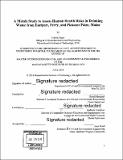A metals study to assess human health risks in drinking water from Eastport, Perry, and Pleasant Point, Maine
Author(s)
Segev, Tchelet
DownloadFull printable version (21.71Mb)
Other Contributors
Massachusetts Institute of Technology. Department of Civil and Environmental Engineering.
Advisor
Harold Hemond and Kathleen Vandiver.
Terms of use
Metadata
Show full item recordAbstract
This study analyzed drinking water for a subset of health concerns expressed by residents in the towns of Eastport, Perry, and Pleasant Point. The town of Pleasant Point is located in the Passamaquoddy tribe's reservation, and all three towns are located in the Boyden Lake watershed in Maine. Water is consumed from several sources, including private wells, the Passamaquoddy Water District (PWD) public distribution system, and surface water sources. Arsenic occurrences in groundwater are known in the state of Maine, and at community meetings residents expressed their concerns about their drinking water quality and the possibility of negative health effects associated with their water. Community meetings were held to listen to these concerns and enlist community members in collecting water for analysis. Boyden Lake water and sediment samples as well as water samples from various points in the PWD distribution system were also collected. All samples were analyzed using an Agilent 7900 inductively coupled plasma mass spectrometer for a suite of metals that included arsenic (As) and lead (Pb), the metals of primary concern, as well as aluminum (Al), chromium (Cr), iron (Fe), cobalt (Co), nickel (Ni), copper (Cu), zinc (Zn), selenium (Se), and cadmium (Cd). Non-metal water quality parameters (e.g. bacterial counts, nitrate, etc.) were not within the scope of the study. The results indicated that EPA drinking water quality guideline exceedances occurred primarily for As and Mn in the well water samples from Perry and Eastport. Isolated Pb exceedances were observed in samples from Eastport wells and PWD water samples, and in Perry well water samples. However, test results also indicated that flushing water (running the water for at least two minutes prior to use) lowered metal concentrations, and hence any potential health risk, significantly. Two kinds of risk analysis studies were applied using sample results, namely the hazard index (a non-carcinogenic risk analysis) and a carcinogenic risk analysis, using standard risk models. For the metals in this study, PWD water had lower non-carcinogenic risk and a lower carcinogenic risk than well water sources. The calculated carcinogenic risk was higher, however, in PWD water than well water when trihalomethanes and haloacetic acids (TTHMs and HAA5) concentrations averaged from 2010-2016 from other studies of PWD water were included in the analysis. The total calculated risk level due to well and PWD water, including metals in this study plus average TTHM and HAA5 concentrations, is equivalent to less than one lifetime cancer incidence across all three communities. Arsenic, present in excess of EPA guidelines in several wells, was calculated to pose a risk of IQ deficit to some children; calculations according to the model used in the study estimate that 6.6±2.3 children between 3rd to 5th grade are susceptible to having IQ deficits of the order of 6 points due to arsenic levels present in samples submitted of household well water. Overall, Pb and As exceedances were not observed in the PWD water distribution system, and the PWD treatment plant further improved water quality in the case of the metals studied. Household filtration also reduced concentrations of metals, with some exceptions, suggesting that some households would benefit from use of water filters, but that continuing maintenance of filters is critical. For reasons of data privacy, only generalized results of the study were included in this report, while individual household results were reported back to residents along with information on resources for remediation and recommendations.
Description
Thesis: M. Eng., Massachusetts Institute of Technology, Department of Civil and Environmental Engineering, 2018. Cataloged from PDF version of thesis. Includes bibliographical references (pages 45-52).
Date issued
2018Department
Massachusetts Institute of Technology. Department of Civil and Environmental EngineeringPublisher
Massachusetts Institute of Technology
Keywords
Civil and Environmental Engineering.